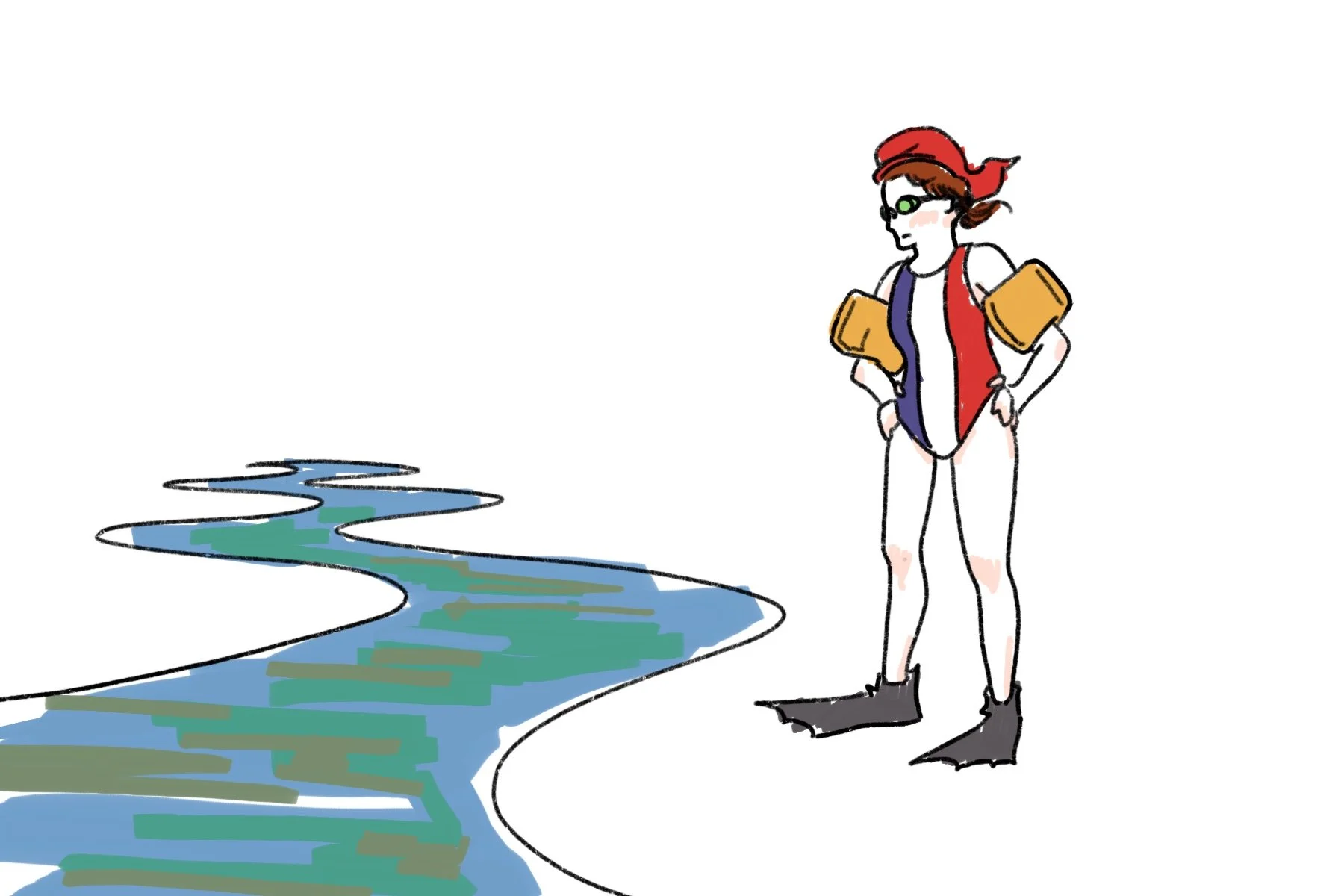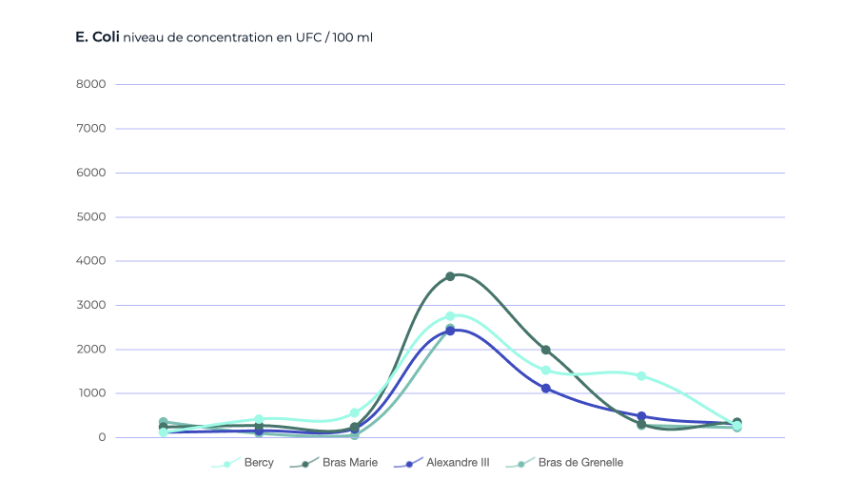Pollution in the Seine
Risa Zhou ’28
Ellen Chen ’25
The Seine, a Paris landmark and France's second-longest river, is no doubt a vital waterway. Unfortunately, due to pollution, swimming has long been prohibited in this 485-mile-long canal. However, the issue is not as simple as mere plastic waste, as the Seine has been found to contain high amounts of Escherichia coli (E. coli) and Enterococci bacteria that jeopardize human safety. While both of these microbes live in the intestinal tracts of humans, certain strains of E. coli are more dangerous than others, and the presence of Enterococci is just as concerning. It indicates the existence of fecal waste in water, which heightens “the possible presence of disease-causing bacteria, viruses, and protozoa.” (US EPA, 2013). Typically, stormwater runoff contributes to this problem, because when it rains, the water that does not enter the sewers makes its way through streets, picking up dirt, bacteria, pesticides, and other pollutants, eventually bringing these contaminants into streams and rivers, harming aquatic ecosystems and human health.
According to the World Triathlon, acceptable levels of E. coli should not exceed 900 CFU (colony forming units)/100mL, and 330 CFU/100mL for enterococci. (WORLD TRIATHLON WATER QUALITY STATEMENT, n.d.). As seen in Figures 1 and 2, the concentration of bacteria in the river is considered very unsafe. Past reports (Figures 3 and 4) by the water monitoring organization, Eau de Paris, show that E. coli and Enterococci levels during the 2024 Summer Olympics frequently exceeded safe standards. The graphs record how the weather impacts the quality of water, with the concentration of bacteria spiking after precipitation.
To alleviate this, Paris has spent 3 years building the “Bassin d'Austerlitz” (Basin of Austerlitz), which is a huge underground reservoir used to store excess rainwater and prevent it from contaminating the Seine. This was part of the Swimming Plan, which hopes to make the Seine swimmable by 2025. However, its effectiveness is unclear, as “heavy rain around the night of the opening ceremony may have seen more pollutants flushed into the water despite all the new infrastructure, possibly leading to the current health issues reported by triathletes.” (O’Sullivan, 2024)
In conclusion, the Seine has been polluted with dangerous levels of E. coli and Enterococci for more than a century. Although the 2024 Paris Olympics accelerated the mission to clean the water, there are still some ways to go for people to swim in the Seine without risking health issues. However, the river is much cleaner than before, and with new infrastructure to assist the effort, the future of the Seine is hopefully in good hands.
Figure 1:
Concentration of E. coli in CFU/100mL
Note. This figure shows the amounts of E. coli recorded at four different points of the Seine River from the 28th of August to the 3rd of September 2024. Météo de la Seine : quelle est la qualité de l’eau du fleuve ? (n.d.). www.paris.fr. https://www.paris.fr/pages/meteo-de-la-seine-quelle-est-la-qualite-de-l-eau-du-fleuve-27467
Figure 2
Concentration of Enterococci in CFU/100mL
Note. This figure shows the concentration of Enterococci at four different points of the Seine River from the 28th of August to the 3rd of September 2024. Météo de la Seine : quelle est la qualité de l’eau du fleuve ? (n.d.). www.paris.fr. https://www.paris.fr/pages/meteo-de-la-seine-quelle-est-la-qualite-de-l-eau-du-fleuve-27467
Figure 3
Concentration of E. coli in CFU/100mL
Note. This figure shows the concentration of E. coli at four different points of the Seine River from the 26th of July to the 7th of August 2024. Goury-Laffont, V., & Coi, G. (2024, August 9). Here’s what the data shows on Seine pollution levels during the Olympics. POLITICO; POLITICO. https://www.politico.eu/article/france-seine-pollution-paris-olympics-data-triathlon-e-coli/
Figure 4
Concentration of Enterococci in CFU/100mL
Note. This figure shows the concentration of Enterococci at four different points of the Seine River from the 26th of July to the 7th of August 2024. Goury-Laffont, V., & Coi, G. (2024, August 9). Here’s what the data shows on Seine pollution levels during the Olympics. POLITICO; POLITICO. https://www.politico.eu/article/france-seine-pollution-paris-olympics-data-triathlon-e-coli/
References:
Basin of Austerlitz – MAX FRANK. (n.d.).
www.maxfrank.com. https://www.maxfrank.com/intl-en/projects/entries/bassin-dAusterlitz-paris-FR.php
Bose, D. (2024, July 30). Here’s what to know about Seine River water quality during the Paris Olympics. AP News.
https://apnews.com/article/olympics-2024-seine-water-quality-bacteria-f04236aa61b936912f9af65f7e3fa9ba
Cleveland Clinic. (2020, September 21). E. coli Infection. Cleveland Clinic; Cleveland Clinic.
https://my.clevelandclinic.org/health/diseases/16638-e-coli-infection
Goury-Laffont, V., & Coi, G. (2024, August 9). Here’s what the data shows on Seine pollution levels during the Olympics.
POLITICO; POLITICO. https://www.politico.eu/article/france-seine-pollution-paris-olympics-data-triathlon-e-coli/
Has bathing in the Seine become a possibility with the construction of the Austerlitz basin? (n.d.). Www.paris.fr.
https://www.paris.fr/en/pages/has-bathing-in-the-seine-become-a-possibility-with-the-construction-of-the-austerlitz-basin-27161
Météo de la Seine : quelle est la qualité de l’eau du fleuve ? (n.d.). Www.paris.fr.
https://www.paris.fr/pages/meteo-de-la-seine-quelle-est-la-qualite-de-l-eau-du-fleuve-27467
News, A. (2024, June 15). Unsafe levels of E. coli found in Paris’s Seine River less than two months before Olympics. Abc.net.au; ABC
News. https://www.abc.net.au/news/2024-06-15/e-coli-river-seine-paris-olympic-games-unsafe-bacteria-swimming/103983150
O’Sullivan, F. (2024, July 23). How Paris Cleaned Up the Seine, and Where to Swim. Bloomberg.com.
https://www.bloomberg.com/news/features/2024-07-23/how-paris-cleaned-up-the-seine-ahead-of-2024-olympics-and-where-to-swim
Schwaller, F. (2024, July 30). Paris Olympics: Why is the Seine unsafe for swimmers? Dw.com; Deutsche Welle.
https://www.dw.com/en/paris-olympics-why-is-the-seine-unsafe-for-swimmers/a-69809143
Team, S. W. M. (2024, May 10). Paris unveils massive underground water storage basin to clean up Seine River ahead of Olympics.
Smart Water Magazine. https://smartwatermagazine.com/news/smart-water-magazine/paris-unveils-massive-underground-water-storage-basin-clean-seine-river
Tests show Paris’ Seine River still has unsafe E. coli levels with Olympics less than a month away. (2024, June 28). AP News.
https://apnews.com/article/olympics-paris-seine-bacteria-ecoli-e69ad9a9f84ca988b1b5ba1a9f701e29
US EPA. (2013, December 4). Indicators: Enterococci. US EPA.
https://www.epa.gov/national-aquatic-resource-surveys/indicators-enterococci
WORLD TRIATHLON WATER QUALITY STATEMENT. (n.d.).




